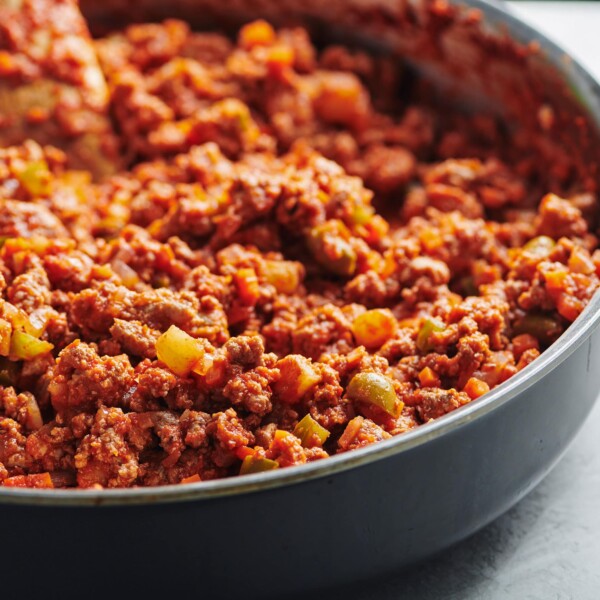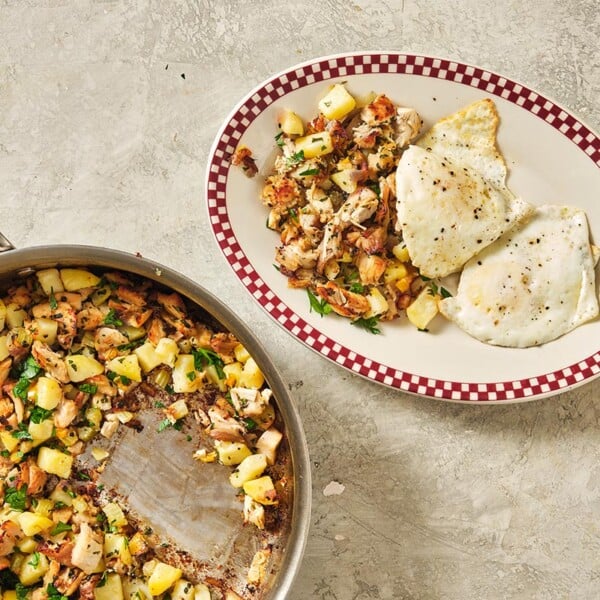Turkey Stock
on Nov 14, 2023, Updated Jan 19, 2025
This post may contain affiliate links. Please read our disclosure policy.
Make use of ALL of the turkey leftovers, and end up with a rich, flavorful stock that can be put to use in so many ways (and also frozen!).

Homemade turkey stock will improve any soup, sauce, or dish you use it in. While there are plenty of decent canned and boxed stocks and broths available, nothing compares to the flavor of homemade. It has such depth of flavor and richness, and you can truly taste the freshness of the ingredients, even though they have been well-simmered and melded.
One of the greatest things about making turkey stock is how perfectly it makes use of all of those Thanksgiving roast turkey leftovers. Simply take any and all leftover parts of the bird — the bones, small bits of meat that are attached to the carcass or haven’t been eaten, plus all of the skin and bits and pieces of the bird — and place them into a large soup pot with a generous amount of water. Then add a variety of staple vegetables and simmer away for at least an hour. Skim, strain, and you have stock. This is a very flexible recipe, so adjust ingredients and proportions as you see fit.
By signing up, you agree to our Privacy Policy.
When you are making your own homemade stock, you can use every part of the bird and waste nothing. Like, NOTHING — anything BUT the giblets and the liver can be added to the pot. Not only is this a more respectful way to enjoy meat, but it’s also very economical. And it’s pretty safe to say that these days, with inflation being where it is, we are all trying to stretch our food-buying dollars. So, buy that slightly larger sized turkey — when your house smells like Thanksgiving once again the next day, you can start to daydream about how to use that flavorful turkey stock in all kinds of recipes, from Leftover Turkey Split Pea Soup to Turkey Pot Pie to Turkey Tetrazzini.
What's In This Post?

Turkey Stock: How to make use of ALL of the turkey leftovers, and end up with a rich, flavorful stock that can be put to use in so many ways (and also frozen!).
What Is the Difference Between Turkey Stock and Broth?
The words stock and broth are often used interchangeably. I usually think of stock as made with bones that have been roasted in some way and as more concentrated than broth. Broth is usually made with vegetables and raw meat. Stock might have a more depth of flavor than broth due to the roasted poultry or meat bones. But different people use different terms, and in most cases, you can consider turkey broth and turkey stock the same thing. Some people call this turkey bone broth.
For my turkey stock, I simply simmer the leftover turkey bones, skin, and bits and bobs with vegetables in water until they have imparted their flavor to the liquid. The longer you simmer the stock, the more it reduces and becomes deeper and richer in flavor and slightly darker in color. Then you can call it whatever you like!
Ingredients for Turkey Broth

- Turkey leftovers – Use everything! Leftover bits of meat, scraps, wings, and skin from 1 roasted turkey).
- Carrots – Scrubbed or peeled and cut into 1-inch pieces.
- Celery – Cut into 1-inch pieces.
- Onion – Unpeeled and quartered.
- Bay leaves
- Dry white wine – Optional.
- Whole black peppercorns – or a generous amount of ground black pepper.
- Kosher salt – If your turkey was brined or heavily salted, you may not need to add much, if any, salt to the broth. Taste the broth when it is close to done — and add more if needed.
- Cold water
Variations
- If you’re a dedicated stock maker, you can keep vegetable scraps in a sturdy, sealed bag in the freezer. Don’t overlook the stems of fresh herbs and peelings from various cleaned vegetables. Another smart, economical kitchen practice.
- The vegetables used in stock can be as simple as onions, carrots, celery, and maybe some fresh herbs. Or you can add a broader range of vegetables.
- Steer away from very distinctively flavored vegetables like broccoli, asparagus, or mushrooms unless you are prepared for a potently flavored broth. Same for members of the cabbage family, like Brussels sprouts. Be thoughtful about adding garlic, which can tend to overpower the flavor of the stock if used in large quantities. Red beets will affect the color in an obvious way!
- Other ingredients can be added if you intend to use your stock in a particular way. An Asian-inspired stock benefits from the addition of fresh ginger or perhaps lemongrass, for instance.
- Add some minced fresh herbs at the end of the simmering time, such as sage, rosemary, thyme, or fresh parsley.
How to Make Turkey Stock
- Prepare the turkey and veggies: Place the turkey bones and scraps into a large stockpot or Dutch oven. Cut up the veggies, adding them to the pot with bay leaves, wine, peppercorns, salt, and water.
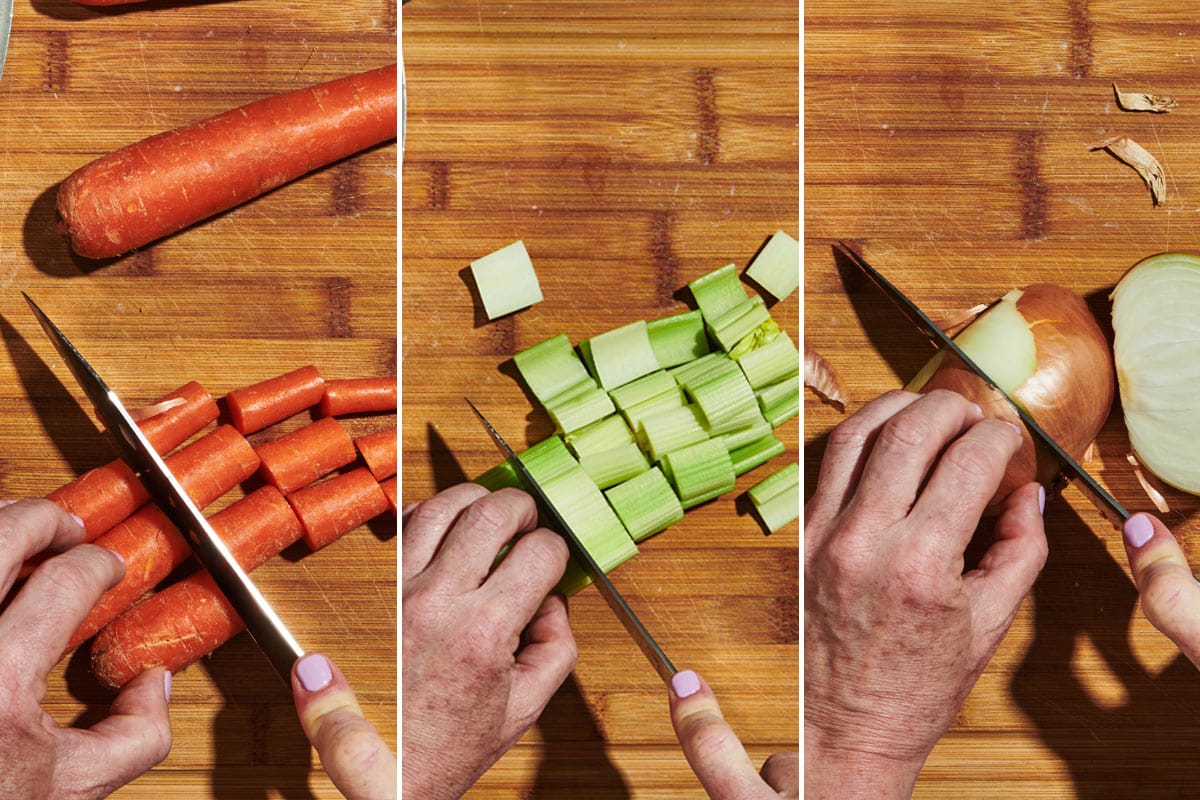
- Simmer: Over medium-high heat, simmer the stock for 1 to 2 hours, pressing the bones as the stock reduces.
- Strain the stock: Using a colander or fine mesh sieve, strain the stock and discard the solids. Let the stock cool.
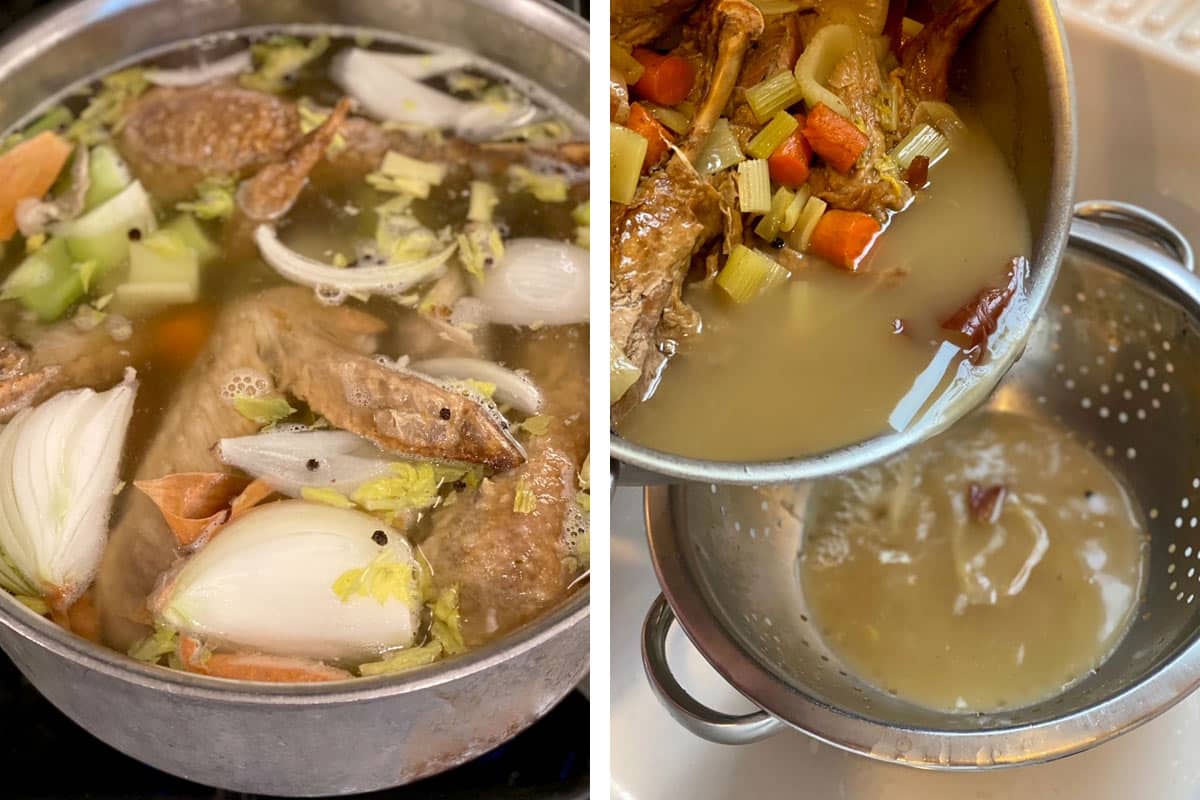
- Store: The stock can be stored in the fridge or frozen in large ice cube trays. Use it in your favorite recipes!
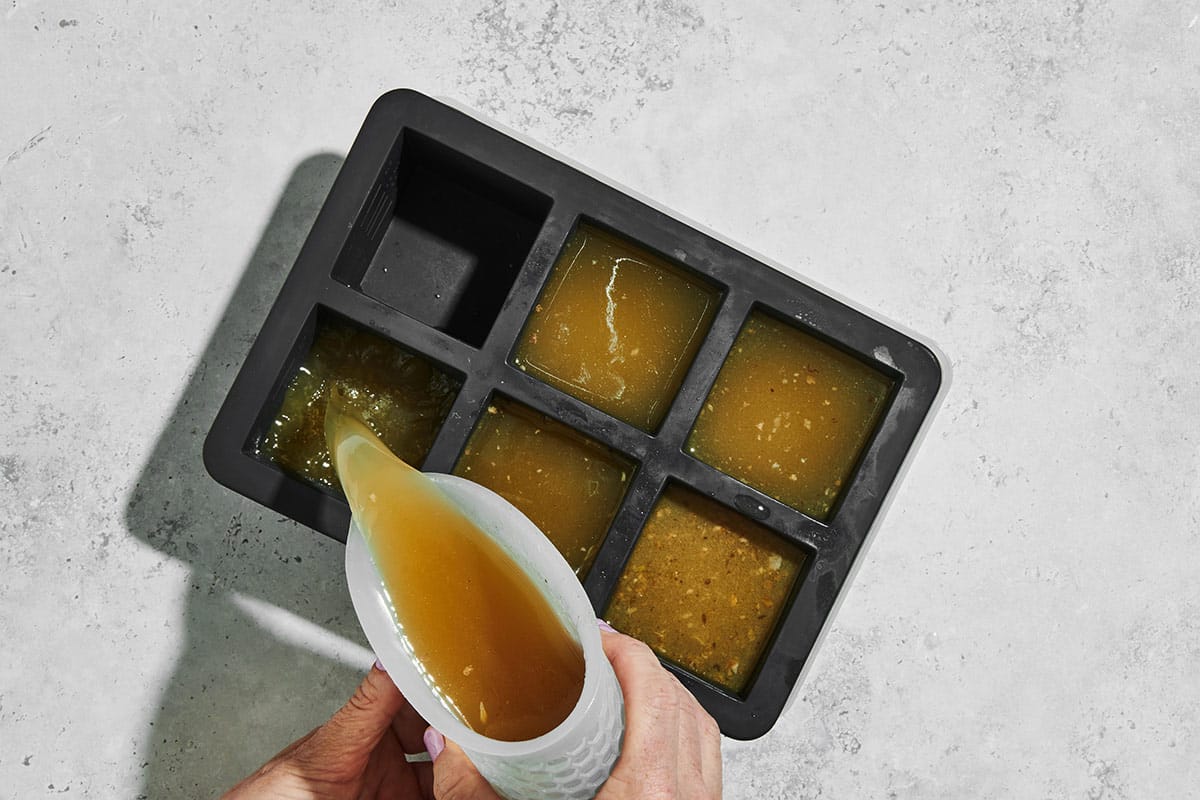
Pro Cooking Tips
- Start your stock with cold water, which will prevent the stock from becoming cloudy.
- Never allow the stock to come to a boil. This can cause a cloudy stock and also make it difficult to “defat” the stock later, as the fat will not congeal on top when cooled and be easily removable. Keep the stock at a very gentle simmer, with the bubbles slowly appearing at the surface. Adjust the heat as necessary.
- Skim the stock as it simmers: some foam will rise to the top and can be scooped out as it cooks. It’s not harmful, but skimming as you cook will result in a clearer stock with a cleaner flavor.
- Straining the stock through a fine-mesh strainer will result in a clearer broth.
- Defat (or partially defat) the stock. Once the stock is strained, allow it to cool completely and put it in the fridge. Once cold, the fat will rise to the top and can be easily scooped off with a spoon. You may choose to leave a bit of the fat, which will make the stock richer when you reheat it. Note that homemade stock will tend to thicken and become a bit gelatinous when it is chilled but will liquefy immediately upon heating.
- To reduce stock after it has been strained and defatted, reheat it in a large broad pot until it reduces to your desired intensity and color. The wider the pot, the more quickly it will reduce. Reducing the stock concentrates the flavor.
- If your turkey was brined or heavily salted, you may need less salt — taste the broth when it is close to done — you can always add more towards the end! You may want to add a bit more black pepper at the end, too.

Storage
Turkey stock can be refrigerated for up to 4 days or frozen for up to 4 months. Think about the amounts of stock you are most likely to need and freeze them in appropriately sized storage containers. When you pour it into the containers, leave about 1/2 inch of headroom as the liquid will expand a bit when it freezes, and you don’t want it to pop off the top of the containers. I also love the jumbo ice cube trays for freezing 1-cup portions of stock for sauces and casseroles.
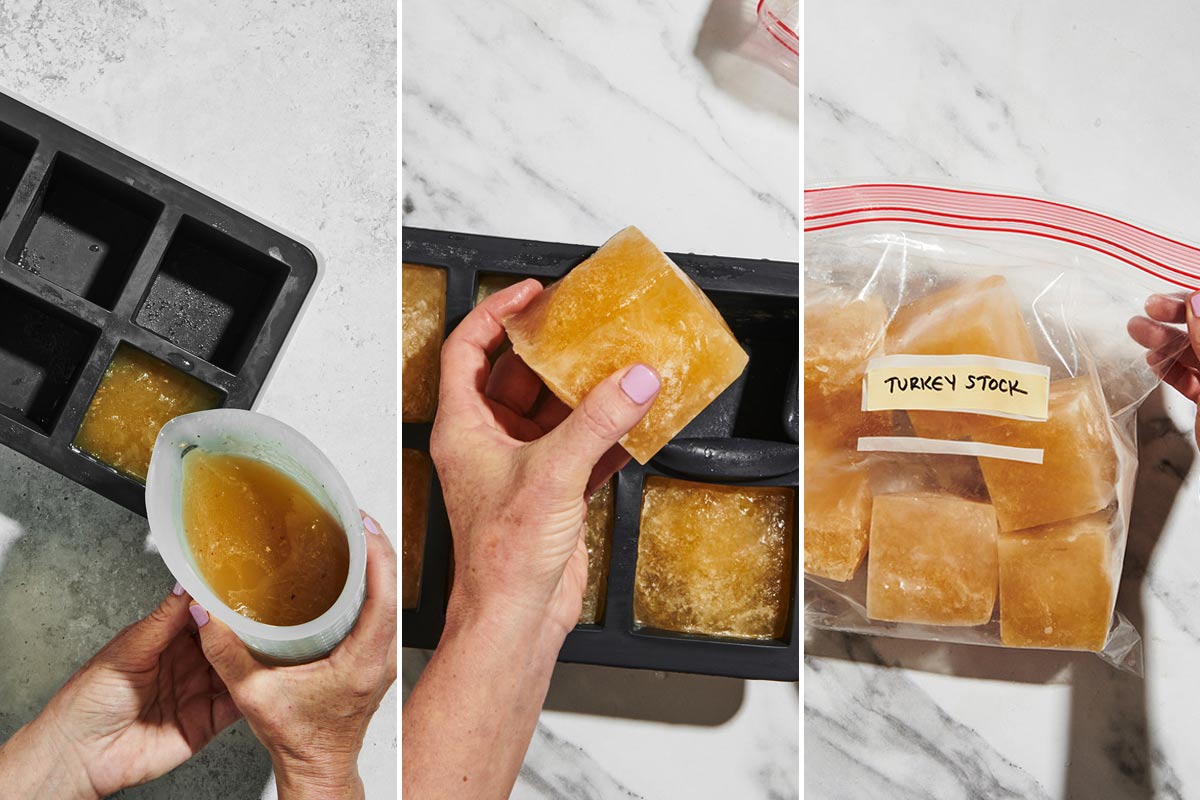
How to Use Turkey Stock
Turkey stock can be subbed in for chicken stock in almost every instance — it has a slightly more pronounced flavor, but it’s poultry stock just the same! You can often sub it in for beef stock as well. And if you have a recipe that calls for vegetable stock or broth, but you don’t mind if it’s not vegetarian, you can use it there as well.
Turkey stock can be used as the base of soups and sauces, as well as in casseroles and skillet dishes. In general, it’s great wherever broth or stock is called for. It’s also perfect for making a pan sauce.

More Leftover Turkey Recipes
Pin this now to find it later
Pin It
How to Make Turkey Stock from Leftover Turkey
Ingredients
- Turkey bones (leftover bits of meat, scraps and skin from 1 roasted turkey)
- 6 carrots (scrubbed and cut into 1-inch pieces)
- 8 celery stalks (cut into 1-inch pieces)
- 1 large onion (unpeeled and quartered)
- 2 bay leaves
- 1 cup dry white wine (optional)
- 1 tablespoon whole black peppercorns
- 1 teaspoon kosher salt (or to taste; see Note)
- 5 quarts cold water
Instructions
- Place the turkey bones and all scraps into a large stockpot, big enough to hold them with some room to spare. Add the carrots, celery, onion, bay leaves, white wine (if using), peppercorns, salt, and water into the pot. The water should cover the bones, or at least almost cover them, but it should be at least an inch below the top of the rim of the pot. Bring the water to a simmer over high heat, then reduce it immediately and keep the liquid gently simmering. Simmer for 1 to 2 hours, depending on how intense you want the stock. Press the bones down into the stock as it reduces, but it’s okay if the liquid lowers below the top of the turkey bones. Use a spoon to skim any foam that rises to the top off periodically as it simmers.
- Strain the stock through a colander or fine mesh sieve and discard the solids. Cool the stock, then place it in the fridge, either in a large pot or in quart containers. When the stock is chilled scrape most or all of the fat from the top. Use as desired in various recipes. Turkey stock can be refrigerated for up to 4 days or frozen for up to 4 months.
Notes
- The vegetables used in stock can be as simple as onions, carrots, and celery, maybe some fresh herbs. Or you can add a broader range of vegetables.
- If you’re a dedicated stock maker, you can keep vegetable scraps in a sturdy, sealed bag in the freezer. Don’t overlook the stems of fresh herbs and peelings from various cleaned vegetables. Another smart, economical kitchen practice.
- Steer away from very distinctively flavored vegetables like broccoli, asparagus, or mushrooms unless you are prepared for a potently flavored broth. Same for members of the cabbage family, like Brussels sprouts. Be thoughtful about adding garlic, which can tend to overpower the flavor of the stock if used in large quantities. Red beets will affect the color in an obvious way!
- Other ingredients can be added if you intend to use your stock in a particular way. An Asian-inspired stock benefits from the addition of fresh ginger or perhaps lemongrass, for instance.
- Don’t allow the stock to come to a boil. This can cause a cloudy stock and also make it difficult to “defat” the stock later, as the fat will not congeal on top when cooled and be easily removable. Keep the stock at a very gentle simmer, with the bubbles slowly appearing at the surface.
- Skim the stock as it simmers: some foam will rise to the top and can be scooped out as it cooks. It’s not harmful, but skimming as you cook will result in a clearer stock with a cleaner flavor.
- Defat (or partially defat) the stock. Once the stock is strained, allow it to cool completely and put it in the fridge. Once cold, the fat will rise to the top and can be easily scooped off with a spoon. You may choose to leave a bit of the fat, which will make the stock richer when you reheat it. Note that homemade stock will tend to thicken and become a bit gelatinous when it is chilled but will liquefy immediately upon heating.
- To reduce stock after it has been strained and defatted, reheat it in a large broad pot until it reduces to your desired intensity and color. The wider the pot, the more quickly it will reduce. Reducing the stock concentrates the flavor.
- If your turkey was brined or heavily salted, you may need less salt — taste the broth when it is close to done – you can always add more towards the end!






